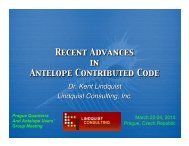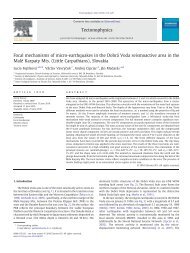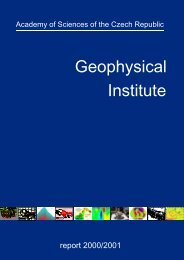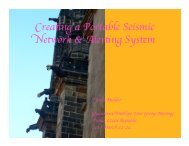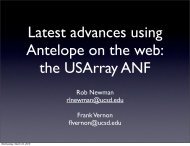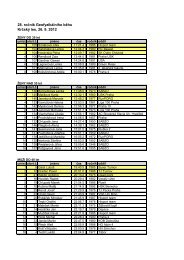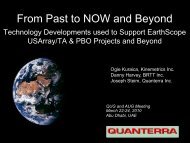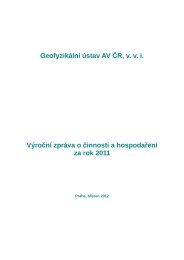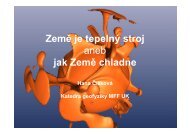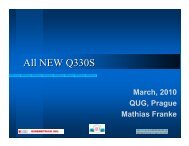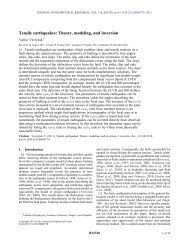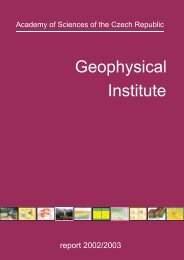Geophysical Institute of the ASCR
Geophysical Institute of the ASCR
Geophysical Institute of the ASCR
Create successful ePaper yourself
Turn your PDF publications into a flip-book with our unique Google optimized e-Paper software.
KRC_P<br />
KRC_S<br />
NKC_P<br />
SKC_S<br />
0 0.1 0.2 s<br />
0 0.1 0.2 s<br />
Fig. 22. Example <strong>of</strong> waveform modelling <strong>of</strong> a double-event. For <strong>the</strong> selected P- and S-wave groups three<br />
seismograms are shown: empirical Green’s function at top, and real (black line) and syn<strong>the</strong>tic (red line)<br />
seismograms at bottom. Note <strong>the</strong> complex waveform character <strong>of</strong> <strong>the</strong> real seismograms compared to <strong>the</strong> EGF<br />
ones displayed namely at <strong>the</strong> P-wave groups.<br />
waveform <strong>of</strong> a colocated small event was used as an empirical Green’s function. Thus, assuming<br />
similar focal mechanisms <strong>of</strong> <strong>the</strong> sub-events, <strong>the</strong> coordinates and origin times <strong>of</strong> <strong>the</strong> sub-events<br />
were searched. As a result <strong>the</strong> geometry and timing <strong>of</strong> <strong>the</strong> sub-events were obtained for 18 <strong>of</strong> <strong>the</strong><br />
54 analyzed multiple-events.<br />
It was found that <strong>the</strong> average speed <strong>of</strong> <strong>the</strong> link between sub-events equals 3.0±0.9 km/s, a value<br />
typical for rupture propagation <strong>of</strong> large earthquakes. The later sub-events occurred far<strong>the</strong>r than <strong>the</strong><br />
rupture radius <strong>of</strong> <strong>the</strong> first sub-event, and <strong>the</strong>ir mutual distance scaled with magnitude. It suggests<br />
that <strong>the</strong> multiple-events share a common fault surface and that <strong>the</strong>ir sub-events represent<br />
individual rupture episodes. The angular distribution <strong>of</strong> <strong>the</strong> position vectors <strong>of</strong> later sub-events<br />
indicates that many <strong>of</strong> <strong>the</strong>m result from a slip-parallel rupture growth.<br />
The obtained results imply that <strong>the</strong> 2000-earthquake swarm corresponds, as a matter <strong>of</strong> fact, to<br />
a progressive rupturing on one nearly vertically dipping fault plane. The swarm activity proved<br />
a substantial self-organization due to a significant impact <strong>of</strong> <strong>the</strong> Coulomb stress changes induced<br />
by slips <strong>of</strong> prior events on <strong>the</strong> ensuing ones; both static and dynamic stress field changes are<br />
concerned in triggering <strong>of</strong> subsequent swarm earthquakes. The self-organization appears to act at<br />
a wide range <strong>of</strong> interevent times, from fractions <strong>of</strong> second for multiple-events to hours for<br />
immediate aftershocks. The Coulomb stress perturbations act very likely in a co-action with a high<br />
pore pressure <strong>of</strong> fluids injected from a deep-seated source, which locally decreases <strong>the</strong> strength <strong>of</strong><br />
rock at <strong>the</strong> fault. This results in lateral stress heterogeneities along <strong>the</strong> fault plane, whose temporal<br />
variations might be responsible for <strong>the</strong> observed migration <strong>of</strong> <strong>the</strong> earthquakes during <strong>the</strong> swarm.<br />
References<br />
Fischer T., 2003. The August-December 2000 Earthquake swarm in NW Bohemia: <strong>the</strong> first results based on automatic<br />
processing <strong>of</strong> seismograms. J. Geodynamics, 35/1-2, 59-81.<br />
Fischer T., 2005. Modelling <strong>of</strong> multiple-events using empirical Greens functions: method, application to swarm earthquakes<br />
and implications for <strong>the</strong>ir rupture propagation. Geophys. J. Int., doi:10.1111/j.1365-246X.2005.02739.x.<br />
Fischer T. and Horálek J., 2005. Slip-generated patterns <strong>of</strong> swarm microearthquakes from West Bohemia/ Vogtland (central<br />
Europe): Evidence <strong>of</strong> <strong>the</strong>ir triggering mechanism?, J. Geophys. Res., B05S21, doi:10.1029/ 2004JB003363.<br />
Harris R. A., 1998. Introduction to special section: Stress triggers, stress shadows, and implications for seismic hazard.<br />
J. Geophys. Res., 103, 24,347-23,358.<br />
39



